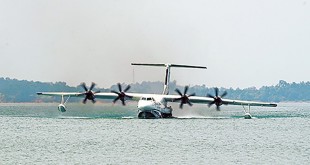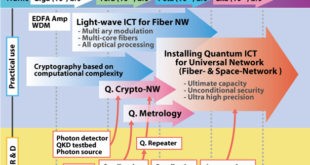A laser is a device that emits a beam of coherent light through an optical amplification process. Laser propulsion is any method of propelling a spacecraft that uses the energy of laser beams.
There are two main types of laser propulsion, depending on whether the laser is onboard or off-board the spacecraft. Onboard methods involve the use of lasers as part of a nuclear propulsion system. One method uses the laser to help expel mass from the spacecraft as in a conventional rocket. This is the more frequently proposed method, but is fundamentally limited in final spacecraft velocities by the rocket equation.
Off-board laser propulsion is part of a larger class of propulsive methods known as beamed-energy propulsion where the energy source is a remote (usually ground-based) laser system and separate from the reaction mass. The propulsive energy comes instead from a fixed, high-power laser beam that is directed onto the spacecraft by a tracking and focusing system. It uses photon radiation pressure to drive momentum transfer and is the principle behind solar sails and laser sails. Off-board techniques have been proposed to boost lightweight vehicles either from the ground to orbit, or on interplanetary or interstellar missions. These techniques include laser-powered launching to orbit and laser light sails.
The Department of Defense has explored the capability of wireless energy transfer across multiple applications. While wireless energy transfer technology has begun adoption in small applications in the commercial space, the capability within the wide range of military applications has only been marginally explored. Multiple technologies related to wireless energy transfer are being researched and developed to sustain the operations of unmanned aerial systems. These UAS could be designed to receive directed energy to reduce the weight of their organic energy storage. This energy transfer ability may extend range and operations, with a similar impact that air-to-air refueling has had on DoD operations.
DARPA launched RFI in July 2022 that seeks information on technologies and innovative solutions that could be feasibly retrofitted onto existing aircraft to expand their role as an airborne energy well by adding the capability to beam laser power to the developing UAS fleet.
DARPA is interested in identifying technologies that can enable the use of existing program(s) of record aircraft (specifically the fleet of KC-46 and KC-135) to support operations by furthering the range and capabilities of new and emerging UAS that possess the ability to receive directed laser energy. A fleet of future advanced UAS equipped with an energy transfer capability would benefit from tactically mobile energy production and distribution without the need for physical connections between platforms. Currently, this energy well concept is thoroughly understood in traditional air-to-air refueling operations, which extend tactical aircraft operational range, payloads, and endurance. By leveraging power beaming, this same tanker could also recharge a network of UAS wirelessly. For example, this could be accomplished by having an underwing power beaming pod with sufficient power generation and cooling to produce nearly continuous laser output on the order of 100 kW.
Aerial recharging continues to present challenges, and technology analyst Rob Enderle of the Enderle Group explained to ClearanceJobs that there are two issues that any effort will need to address. “One is maintaining the battery capacity of the charge site, and the other is making the physical connection while both the drone and the charging platform are in the air – where both are moving independently of each other,” said Enderle. “The first requires a relatively heavy platform, which is generally best done with a winged design. Still, it would make docking substantially more difficult, increasing the expense of the drones which would then require far higher tolerance for control and likely better proximity sensors.”
The DARPA approach looks to move beyond docking, and this is where the use of lasers or microwaves as the primary energy transmission tech comes into play. DARPA also has multiple projects related to such technology, including its “whisper beam” radio waves that are being developed to recharge UAV swarms.
The Whisper Beam technology utilizes radio waves that can self-focus at the receiver, which enables the UAV to draw kilowatts of power in all weather. These waves are actually somewhat weak, even directly between transmitter and UAV. Moreover, long-distance power transmission would not be impossible.
Yet, the waves would have some limitations, which is why options to use lasers are now being explored. These could offer a different opportunity, and yet it would present its own challenges. At issue is that such a system would have to work in all sorts of weather conditions, where clouds and dust could interfere with the lasers. In addition, there is also the matter of costs to consider.
“It isn’t a case of being unable to do this but keeping the cost of both the charging platform and drones low,” added Enderle. “These weight and cost problems are one of the reasons that lighter-than-air concepts seem to be more attractive for the charging platform because they don’t require a lot of power for lift, and they can hover in place but are more susceptible to weather changes – particularly wind – then heavier than air hovering designs.”
REQUESTED INFORMATION:
Responses are welcome from all capable sources including, but not limited to, private or public companies, individuals, universities, university-affiliated research centers, not-for-profit research institutions, and U.S. Government-sponsored labs. DARPA is interested in responses that address all of the following areas:
- Energy generation: Responses should identify the existing or required additional equipment utilized in an Airborne Energy Well aircraft selected as well as include an initial approximation of the limits of energy generation. The energy generation solution should have sufficient power for a 100 kW or greater continuous wave laser as well as the thermal control for integrating the laser on the existing DoD aircraft.
- Energy transfer: Reponses should identify the specific laser solution capable of +100 kW for a selected Airborne Energy Well aircraft and identify the equipment (existing and/or modified to the aircraft) required to efficiently provide beam forming and steering of the laser energy to remote locations and covering a nearly hemispherical field of regard.
- Adaptation and employment: Responses should include technologies of significant technical readiness (Technology Readiness Level (TRL) 6 or higher) for adaptation and development of the Airborne Energy Well concept; assess the confidence of industry in designing, fabricating, and testing of all components and subsystems; and identify the benefits and challenges in adapting equipment and missions to the Airborne Energy Well role.
References and Resources also include:
https://news.clearancejobs.com/2022/06/29/darpa-charges-ahead-with-rechargeable-drones/
 International Defense Security & Technology Your trusted Source for News, Research and Analysis
International Defense Security & Technology Your trusted Source for News, Research and Analysis

